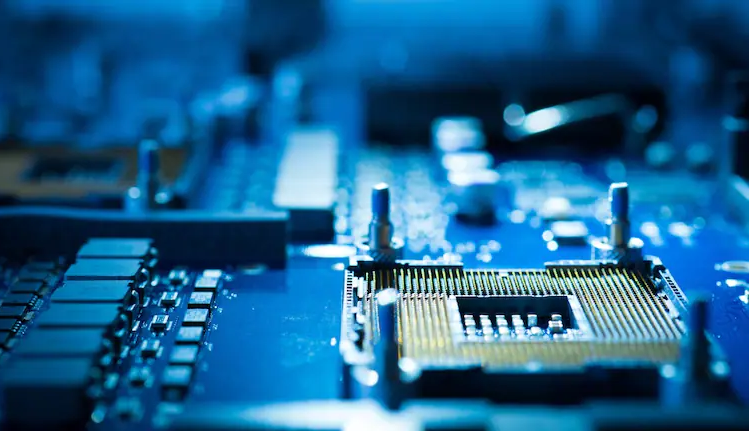Introduction
Semiconductors are essential components in various fields, including healthcare, medical equipment, communications, computers, defence, transportation, clean energy, and emerging technologies like artificial intelligence and quantum computing. The United States continues to be a leader in this industry, with approximately 50 percent of the global market share, valued at $208 billion by 2020. Semiconductors rank among the top five U.S. exports, accounting for over 80 percent of U.S. sales to overseas customers. The American semiconductor industry invests approximately one-fifth of its revenue in research and development, ranking second only to the pharmaceutical industry.
China, another emerging player in the semiconductor industry, is experiencing rapid growth. In 2015, the country held a modest 3.8 percent share of global chip sales, totalling $13 billion. However, by 2020, it made significant progress, achieving an annual growth rate of 30.6 percent and capturing 9 percent of the market, resulting in $40 billion in annual sales. According to the Semiconductor Industry Association, China has surpassed Taiwan for two consecutive years and lags behind only Europe and Japan, each with a 10 percent market share as of 2020. In this industry, annual revenue could reach $116 billion by 2024, securing a market share of nearly 18 percent, placing it second only to the United States and South Korea in terms of global market share. (The Diplomat, 2022)
India’s Vision – A Global Semiconductor Hub
In December 2021, the Indian government approved Rs. 76,000 crore ($10 billion) for an integrated Production Promotion Program (PLI) aimed at attracting semiconductor manufacturers and exhibitors. India is striving to build confidence in semiconductor development and aspires to become a global semiconductor hub. To achieve this, India has launched the “India Semiconductor Mission (ISM),” a dedicated and independent initiative focused on developing a sustainable semiconductor ecosystem.
The Vedanta Group has announced its plans to invest $15 billion in semiconductor production in India within the next five to ten years. The Tata Group is reportedly in discussions with several international companies, including TSMC of Taiwan and UMC for chip manufacturing in India. Tata Group aims to establish a semiconductor assembly and testing centre (OSAT) with a budget of $300 million. They have identified potential locations for the centre in Tamil Nadu, Karnataka, and Telangana. The plant will reportedly assemble and test semiconductor chips using high-quality silicon wafers sourced from semiconductor foundries such as TSMC in Taiwan, according to Fitch Solutions. The government is reportedly supportive of Tata’s proposal. (The Hindu, 2022)
However, the conflict in Russia-Ukraine has led to a shortage of raw materials, including neon gas and palladium, which are essential for semiconductor production. As a result, this could potentially delay India’s semiconductor aspirations.
The Greater Opportunity During the COVID Era
Due to disruptions in supply chains caused by the pandemic and a decrease in production due to COVID safety concerns, there is now a worldwide shortage of semiconductors. Therefore, India has a wide range of opportunities to become a global hub for semiconductors. To date, there are proposals totalling $20.5 billion from five semiconductor setup companies and production units. Semiconductor production involves several steps, including research and development, design, integration, testing, marking, packaging (ATMP), etc. India plans to capture a significant share of the ATMP component, representing approximately 10% of the semiconductor business revenue.
India has a significant advantage in its abundance of low-skilled workers. State leaders are planning to establish 20 semiconductor design companies to gain a foothold in the semiconductor design industry. Design accounts for 30 percent of the semiconductor industry, and it is also environmentally friendly. (Business Standard, 2022)
More Needs to Be Done
India has a limited presence in the semiconductor industry, primarily focused on strategic applications. India’s current semiconductor centres include the Semi-Conductor Laboratory (SCL) in Mohali, the Gallium Arsenide Enabling Technology Centre (GAETEC) in Hyderabad, and the Society for Integrated Circuit Technology and Applied Research (SICTAR) in Bengaluru. But that could change if New Delhi took the initiative to bring in more talent and investment. Prime Minister Narendra Modi’s speech at the Indian Mobile Congress highlighted India’s aspirations. The Prime Minister stated, “From 5G technology to artificial intelligence, virtual reality, cloud computing, the internet of things, and robotics, the world is looking to India for approved technology with affordable and sustainable solutions.” The government has begun recognizing the important role that semiconductors and demonstrations will play in the foundation of modern electronics that drive the next phase of digital transformation under Industrial 4.0.
Semiconductors and signal production require substantial investment and advanced technology, and India needs both financial support and technical cooperation. Meanwhile, in another significant development, the government is reportedly in talks with Taiwan to establish a semiconductor manufacturing facility in India. The Indian government has already identified several potential sites for this purpose. If negotiations succeed, one of Taiwan’s largest semiconductor manufacturers, such as Taiwan Semiconductor Manufacturing Company (TSMC) or United Microelectronics Corporation (UMC), may set up operations in India. There is also domestic interest in the semiconductor industry.
Russia – Ukraine war impact
India is initiating local semiconductor production to reduce its dependence on other countries, but the ongoing Russia-Ukraine war, if it continues in the long run, could jeopardize India’s aspirations for high semiconductor productivity and global dominance. Experts suggest that given the current tensions spanning from Asia to Europe and affecting both semiconductor production and raw material supply, Indian stakeholders should reconsider their growth and investment strategies. India relies on the export of various materials from Russia and Ukraine, including neon gas, Chemical C4F6, and essential metals like palladium, nickel, platinum, rhodium, and titanium, all crucial for semiconductor production. According to experts, black swan events like the ongoing war, which can cause significant disruptions in global supply chains, may also impact chip volume and lead to spikes in chip prices. Production Linked Incentive (PLI) programs and initiatives to promote electronic component and semiconductor production have led to the shift of production from other countries to India. However, in such cases, a shortage of essential materials could potentially hinder progress. A recent report by the US Department of Commerce on the semiconductor supply chain predicted global chip shortages in the latter part of 2022, that spilled over to 2023. Manufacturers have already experienced reductions in their semiconductor supplies, contributing to a worldwide chip shortage. (Business Standard, 2022)
Recent Developments
Just a few months ago, Prime Minister Narendra Modi met with Kurt Sievers, the CEO of NXP Semiconductors, a prominent Dutch semiconductor designer and manufacturer that plays a pivotal role in the semiconductor manufacturing sector. In March 2023, India and the United States signed a Memorandum of Understanding (MoU) aimed at establishing a collaborative chip supply chain and fostering innovation, all within the framework of the India – US Commercial Dialogue. As a strong testament to India’s commitment to the semiconductor industry, the government has earmarked $10 billion in incentives to fuel the growth of a sustainable semiconductor and display manufacturing ecosystem within the country. (ABP News, 2023)
The government-backed incentive, initially proposed in 2021, is already yielding positive results. Notably, industry giants Foxconn and Vedanta, hailing from the technology and mining sectors, have expressed their intentions to establish a semiconductor and display manufacturing facility through a joint venture in Gujarat. Nevertheless, the government is actively encouraging more industry players to participate in this initiative.
Conclusion
India appears to be making significant strides in expanding its presence in the semiconductor manufacturing sector. Whether these government-sponsored programs will overcome common administrative barriers, red tape, and tax regulation issues remains to be seen. India may soon establish itself as a global semiconductor hub, as it is becoming more receptive to industry leaders than ever before. Other companies, such as the U.S. chipmaker Intel, have also entered the Indian market and expressed interest in establishing semiconductor manufacturing facilities, a proposition that was promptly accepted by the Indian MeitY minister. Environmental impact is something India should always keep in mind as it promotes the semiconductor ecosystem. Planners are also aware of the unfortunate reality that the Ukrainian crisis could potentially delay India’s progress in the semiconductor industry. However, the positive projection that India’s semiconductor market is expected to reach $63 billion by 2026, compared to $15 billion in 2020, is a source of motivation. The India Semiconductor Mission (ISM) aims to develop a sustainable semiconductor ecosystem. (Business Standard, 2022)
References
- (2022, March 29). US plans semiconductor alliance with Taiwan, South Korea, and Japan. https://www.business-standard.com/article/international/us-plans-semiconductor-alliance-with-taiwan-south-korea-and-japan-122032900290_1.html
- Abrar, P. (2022, March 8). Aiming for large chip, electronics investments into India: Union Minister. https://www.business-standard.com/article/economy-policy/aiming-for-large-chip-electronics-investments-into-india-union-minister-122030801382_1.html
- Auto, E. T. (2022, March 12). Ukraine crisis may hit India’s global semiconductor hub dream. https://auto.economictimes.indiatimes.com/news/auto-components/ukraine-crisis-may-hit-indias-global-semiconductor-hub-dream/90173062
- Krishna, G. (2022, February 13). India’s semiconductor dream. The Hindu. https://www.thehindu.com/opinion/op-ed/the-way-ahead-for-indias-semiconductor-dream/article65045904.ece
- Press Trust of India. (2022, April 1). Russia-Ukraine conflict may affect supply chains of semiconductors: MoS IT. https://www.business-standard.com/article/markets/russia-ukraine-conflict-may-affect-supply-chains-of-semiconductors-mos-it-122040101414_1.html
- Srivastava, A. (2021, December 28). India can be a winner in semiconductors. The Hindu Business Line. https://www.thehindubusinessline.com/opinion/india-can-be-a-winner-in-semiconductors/article38057577.ece
- The Diplomat. (2022, February 3). India’s Semiconductor Pursuit. https://thediplomat.com/2022/01/indias-semiconductor-pursuit/
- Tripathi, V. (2023, April 7). India’s Semiconductor Dream: A Brief Introduction Of The Industry, Its Role, And Importance. https://news.abplive.com/. https://news.abplive.com/india-at-2047/india-s-semiconductor-dream-a-brief-introduction-of-the-industry-its-role-and-importance-1593495
AUTHOR:
Heena
[email protected]
B.A. (H) Economics, 3rd Year
Daulat Ram College, University of Delhi


Recent Comments